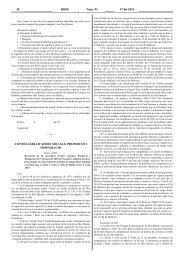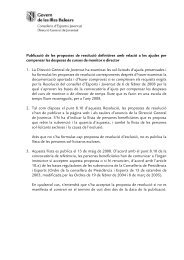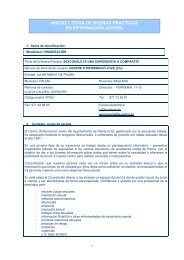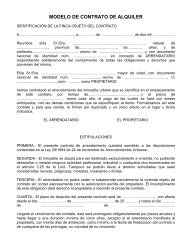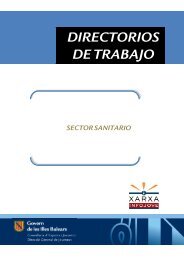Tabla 15. Evolución <strong>de</strong> la fuente principal <strong>de</strong> ingresos <strong>de</strong> los <strong>jóvenes</strong>, 1994-2001Varones 1994 1995 1996 1997 1998 1999 2000 2001NO HA TENIDO NINGÚN TIPO DE INGRESO 27,7 25,6 30,9 28,4 24,1 22,1 17,1 15,8RENTAS DE PROPIEDAD, CAPITAL YTRANSFERENCIAS PRIVADAS 6,4 8,1 4,9 8,3 9,8 9,9 12,7 10,6SUBSIDIOS Y PRESTACIONES DE DESEMPLEO 5,5 3,7 2,8 2,4 1,7 0,8 1,2 1,0PENSIONES CONTRIBUTIVAS Y NO CONTRIBUTIVAS 0,2 0,3 0,5 0,4 0,3 0,4 0,4 0,4OTROS SUBSIDIOS Y PRESTACIONES SOCIALES 5,1 6,0 5,4 5,9 4,5 5,0 4,6 4,4TRABAJO POR CUENTA AJENA 49,7 50,5 50,2 49,6 53,7 55,7 57,3 60,3TRABAJO POR CUENTA PROPIA 5,3 5,7 5,3 4,9 5,8 6,2 6,8 7,5Mujeres 1994 1995 1996 1997 1998 1999 2000 2001NO HA TENIDO NINGUN TIPO DE INGRESO 42,2 41,8 46,5 42,0 39,0 38,7 34,1 30,8RENTAS DE PROPIEDAD, CAPITAL YTRANSFERENCIAS PRIVADAS 7,2 9,0 6,0 9,8 11,5 9,7 13,6 10,6SUBSIDIOS Y PRESTACIONES DE DESEMPLEO 6,2 4,3 2,7 2,7 2,8 2,2 2,3 2,4PENSIONES CONTRIBUTIVAS Y NO CONTRIBUTIVAS 0,3 0,3 0,6 0,6 0,6 0,7 0,5 0,4OTROS SUBSIDIOS Y PRESTACIONES SOCIALES 8,0 8,5 7,9 7,8 6,4 5,2 5,1 5,0TRABAJO POR CUENTA AJENA 33,3 33,6 34,5 34,8 37,8 40,9 42,0 48,3TRABAJO POR CUENTA PROPIA 2,7 2,4 1,8 2,3 2,0 2,6 2,5 2,6Ambos Sexos 1994 1995 1996 1997 1998 1999 2000 2001NO HA TENIDO NINGUN TIPO DE INGRESO 34,9 33,6 38,7 35,0 31,4 30,3 25,6 23,3RENTAS DE PROPIEDAD, CAPITAL YTRANSFERENCIAS PRIVADAS 6,8 8,6 5,4 9,0 10,6 9,8 13,1 10,6SUBSIDIOS Y PRESTACIONES DE DESEMPLEO 5,8 4,0 2,7 2,6 2,3 1,5 1,8 1,7PENSIONES CONTRIBUTIVAS Y NO CONTRIBUTIVAS 0,3 0,3 0,5 0,5 0,5 0,5 0,4 0,4OTROS SUBSIDIOS Y PRESTACIONES SOCIALES 6,5 7,2 6,7 6,8 5,4 5,1 4,8 4,7TRABAJO POR CUENTA AJENA 41,6 42,2 42,4 42,4 45,9 48,4 49,7 54,3TRABAJO POR CUENTA PROPIA 4,0 4,1 3,6 3,7 4,0 4,4 4,7 5,0Fuente: PHOGUE, INEPese a <strong>las</strong> diferencias <strong>de</strong> género persistentes, <strong>las</strong> mejoras experimentadas en los últimos añosanalizados se hacen mas patentes en el grupo <strong>de</strong> <strong>jóvenes</strong> emancipados. Los <strong>jóvenes</strong> emancipadoscuya fuente fundamental <strong>de</strong> ingresos es su trabajo pasaron <strong>de</strong> un 59,9% en 1994 a un 76,8%en 2001; la proporción <strong>de</strong> <strong>jóvenes</strong> <strong>de</strong>pendientes <strong>de</strong> prestaciones y subsidios bajó <strong>de</strong>l 11% al 5,2%en ese periodo. Se redujo también la proporción <strong>de</strong> <strong>jóvenes</strong> <strong>de</strong>pendientes <strong>de</strong> transferencias privadasy los carentes <strong>de</strong> ingresos pasaron <strong>de</strong> ser el 24,5% a representar un 15,2% <strong>de</strong> los emancipados.En general, pues, la mejora <strong>de</strong> la situación laboral ha posibilitado, durante este periodo, elincremento <strong>de</strong> la tasa <strong>de</strong> emancipación, especialmente a partir <strong>de</strong> 1996-1997.Estos datos, a<strong>de</strong>más <strong>de</strong> reflejar la fase alcista <strong>de</strong>l ciclo económico, ponen <strong>de</strong> relieve la permeabilidad<strong>de</strong> la línea separadora <strong>de</strong> los grupos <strong>de</strong> <strong>jóvenes</strong> emancipados y no emancipados, evi-<strong>La</strong> <strong>economía</strong> <strong>de</strong> <strong>las</strong> <strong>personas</strong> <strong>jóvenes</strong>31
Grafico 16: Evolución por edad <strong>de</strong> <strong>las</strong> fuentes <strong>de</strong> ingresos <strong>de</strong> los <strong>jóvenes</strong>, 200190,0016 17 18 19 20 21 22 23 24 25 26 27 28 29 30 31 32 33 34Fuente: PHOGUE, INE80,0070,0060,0050,0040,0030,0020,0010,000,00NO HA TENIDO NINGÚNTIPO DE INGRESOTRABAJO POR CUENTAPROPIA Y/O AJENAPENSIONES, PRESTACIONESY SUBSIDIOSRENTAS DE PROPIEDAD,CAPITAL Y TRANSFER.PRIVADASPolinómica (TRABAJO PORCUENTA PROPIA Y/O AJENA)Polinómica (NO HA TENIDONINGUN TIPO DE INGRESO)Polinómica (PENSIONES,PRESTACIONES Y SUBSIDIOS)Polinómica (RENTAS DEPROPIEDAD, CAPITAL YTRANSFER. PRIVADAS)<strong>de</strong>nciando también el diferente grado <strong>de</strong> la autonomía o <strong>de</strong>pen<strong>de</strong>ncia económica que pue<strong>de</strong>existir <strong>de</strong>ntro <strong>de</strong> cada uno <strong>de</strong> los grupos analizados.Por último, y <strong>de</strong>s<strong>de</strong> el punto <strong>de</strong> vista <strong>de</strong>l análisis por edad, hay que reseñar que, aunque laelevación <strong>de</strong> la edad <strong>de</strong> análisis para los <strong>jóvenes</strong> y su consi<strong>de</strong>ración como tales hasta los 34años, incrementa el porcentaje <strong>de</strong> emancipados y mejora, en general, los valores medios <strong>de</strong>autonomía e in<strong>de</strong>pen<strong>de</strong>ncia económica <strong>de</strong> los <strong>jóvenes</strong>, ello se <strong>de</strong>be mas a la agregación <strong>de</strong>nuevas cohortes <strong>de</strong> treintañeros que al hecho <strong>de</strong> que se produzcan variaciones importantesen la composición <strong>de</strong> fuentes <strong>de</strong> ingresos en el tramo <strong>de</strong> edad ampliado (30-34). <strong>La</strong>s variacionesque se registran en la distribución <strong>de</strong> <strong>las</strong> fuentes <strong>de</strong> ingresos a partir <strong>de</strong> los 30 años sonmuy reducidas y no se observan diferencias notables entre los distintos grupos etáreos unavez superada la treintena.A partir <strong>de</strong> dicha edad (30 años), existe un núcleo importante, en torno al 20% <strong>de</strong> los <strong>jóvenes</strong>,con una fuerte resistencia a la reducción <strong>de</strong> sus <strong>de</strong>pen<strong>de</strong>ncias económicas, <strong>de</strong>bido a que senutre mayoritariamente <strong>de</strong> mujeres <strong>jóvenes</strong> ya emancipadas que renuncian a entrar o a permaneceren el mercado laboral para <strong>de</strong>dicarse al cuidado <strong>de</strong> los hijos y a <strong>las</strong> tareas domésticas (una<strong>de</strong> cada dos mujeres emancipadas carece <strong>de</strong> ingresos <strong>de</strong>rivados <strong>de</strong> su propio trabajo); y también<strong>de</strong> <strong>jóvenes</strong> <strong>de</strong> ambos sexos con dificulta<strong>de</strong>s para acce<strong>de</strong>r al mercado laboral (un 19% <strong>de</strong> los <strong>jóvenes</strong><strong>de</strong> 30 a 34 años no emancipados carecen <strong>de</strong> ingresos).4.4 Salarios y rentas en el PHOGUE 94-2001Hemos visto anteriormente el papel central <strong>de</strong> los salarios <strong>de</strong>ntro <strong>de</strong> los ingresos <strong>de</strong> los <strong>jóvenes</strong>y su carácter <strong>de</strong>terminante para el proceso <strong>de</strong> emancipación. Analizaremos ahora algunosrasgos <strong>de</strong> los salarios y otras fuentes <strong>de</strong> ingresos en relación con <strong>las</strong> variables más características<strong>de</strong> los <strong>jóvenes</strong>, especialmente el sexo, la edad y la situación <strong>de</strong> emancipación.El ingreso medio anual neto <strong>de</strong> los <strong>jóvenes</strong> menores <strong>de</strong> 35 años era en 2001, último año <strong>de</strong> utilización<strong>de</strong> la peseta, <strong>de</strong> 1.242.648 pesetas. El ingreso medio <strong>de</strong> los varones fue <strong>de</strong> 1.419.674,32 ESTUDIOS
- Page 2 and 3: ≥ estudios de juventudLa economí
- Page 4: ÍNDICE1. Introducción . . . . . .
- Page 7 and 8: Gráfico 1: Los jóvenes en la pir
- Page 10 and 11: 2La situación familiar y económic
- Page 12 and 13: Gráfico 3: Situación socio afecti
- Page 14 and 15: 3La situación actual de los jóven
- Page 16 and 17: perfil de actividad de los jóvenes
- Page 18 and 19: 4Los ingresos de los jóvenesDesde
- Page 22: Tabla 8. Proporción de jóvenes em
- Page 25 and 26: Gráfico 10: Evolución de la activ
- Page 27 and 28: Gráfico 11: Evolución de los tipo
- Page 29 and 30: Gráfico 12: Distribución porcentu
- Page 31: Gráfico 14: Evolución de la fuent
- Page 35 and 36: Gráfico 18: Ingresos medios anuale
- Page 37 and 38: Gráfico 19: Ingresos medios anuale
- Page 39 and 40: Gráfico 21: Ingresos (en ptas.) an
- Page 41 and 42: Tabla 19. Tasa acumulada de crecimi
- Page 43 and 44: Gráfico 24: Tasa acumulada de crec
- Page 45 and 46: En cuanto a los emancipados, los po
- Page 47 and 48: Gráfico 28: Peso relativo de los i
- Page 49 and 50: Gráfico 31: Ingresos medios en eur
- Page 51 and 52: Gráfico 34: Ingresos mensuales seg
- Page 53 and 54: Tabla 24. Ingresos medios mensuales
- Page 55 and 56: Tabla 26. Ingresos medios personale
- Page 57 and 58: pación, pasados los 20 años (ante
- Page 59 and 60: Tabla 28. Evolución del número de
- Page 61 and 62: Tabla 29. Evolución del número de
- Page 63 and 64: Gráfico 39: Porcentaje de personas
- Page 65 and 66: del hogar. Sin embargo, estas pregu
- Page 67 and 68: Tabla 33. Ingreso medio neto del ho
- Page 69 and 70: Tabla 34. Ingreso medio neto del ho
- Page 71 and 72: Tabla 35. (continuación)Grupo de e
- Page 73 and 74: Tabla 36. Ingreso medio neto del ho
- Page 75 and 76: Gráfico 45: Porcentaje de hogares
- Page 77 and 78: general, en el momento del consumo
- Page 79 and 80: En esta primera aproximación podem
- Page 81 and 82: Tabla 39. Gasto total medio por hog
- Page 83 and 84:
Gráfico 52: Tasa de variación int
- Page 85 and 86:
Gráfico 54: Evolución del gasto m
- Page 87 and 88:
Tabla 41. Gasto total medio por uni
- Page 89 and 90:
unipersonales o formados por pareja
- Page 91 and 92:
Gráfico 60: Gasto medio por unidad
- Page 93 and 94:
Gráfico 62: Gasto medio por unidad
- Page 95 and 96:
Gráfico 64: Gasto medio por unidad
- Page 97 and 98:
Gráfico 66: Gasto medio por unidad
- Page 99 and 100:
Gráfico 67: Estructura porcentual
- Page 101 and 102:
5.5 La compra de vivienda en los j
- Page 103 and 104:
Tabla 52. Ingresos medios personale
- Page 105 and 106:
pagos, mientras ese porcentaje se d
- Page 107 and 108:
Tabla 56. Número de hogares y porc
- Page 109 and 110:
Tabla 57. Número de hogares y porc
- Page 111 and 112:
umbral de la pobreza (8.509.000), a
- Page 113 and 114:
en nuestro país, no existe un merc
- Page 115 and 116:
La utilización de las líneas de p
- Page 117 and 118:
Actualmente, se ha sustituido por o
- Page 119 and 120:
La diferencia por sexo es muy reduc
- Page 121 and 122:
Tabla 63. Personas por sexo, tramos
- Page 123 and 124:
6. La reducción de las cohortes de
- Page 125 and 126:
ción de los ingresos reales (defla
- Page 127 and 128:
En general, podemos afirmar que las
- Page 129 and 130:
Tabla 25. Ingresos medios personale
- Page 132 and 133:
Índice de gráficosGráfico 1. Los
- Page 134:
Gráfico 66. Gasto medio por unidad
- Page 137 and 138:
Bound, J. y H. Holzer (2000): «Dem
- Page 139 and 140:
Koreman-Neumark (1997), Cohort crow






